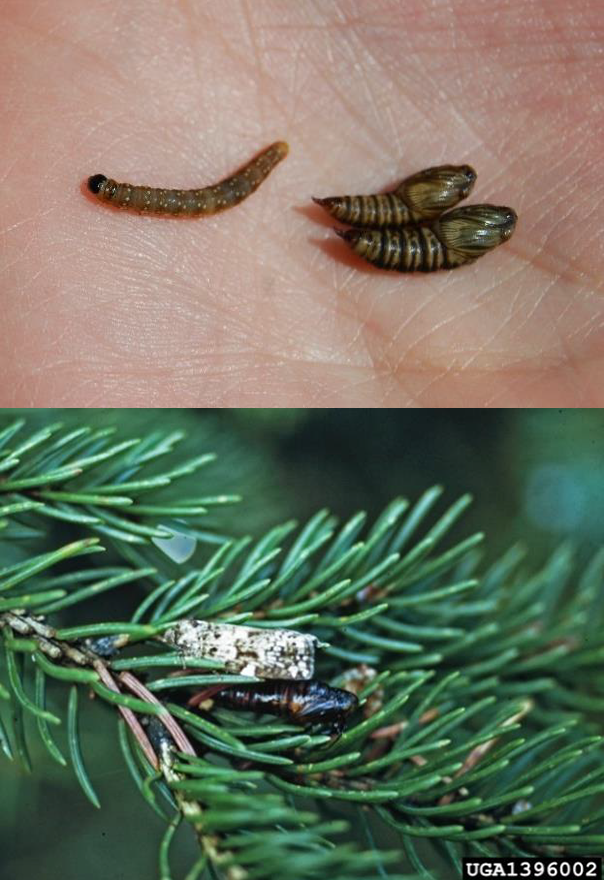DACF Home → Bureaus & Programs → Maine Forest Service → Forest Health & Monitoring → Insect & Disease Fact Sheets →Spruce Budworm
SPRUCE BUDWORM
Choristoneura fumiferana (Clem.)
Host
In Maine, spruce budworm (SBW) feeds primarily on balsam fir (Abies balsamea) and white spruce (Picea glauca), but also readily attacks other spruce species (Picea spp.), larch (Larix laricina), and hemlock (Tsuga canadensis). Occasionally, SBW may also feed on Douglas fir (Pseudotsuga menziesii), white pine (Pinus strobus) and other pine species (Pinus spp.), although when this happens the damage is not substantial.

Life Cycle
The adults emerge in July and are grayish-brown moths marked with white and black spots and a black bar on both wings. These small moths are just over 0.5 inches long with a 1-1.25-inch wingspan and are often referred to as “millers.” Large numbers of moths occasionally congregate in heavily infested stands and can fly great distances with help from atmospheric currents. In late July, female moths lay about 20 eggs at a time in a light green mass on the underside of fir or spruce needles. Over the summer, a single female may lay multiple egg masses and lay a total of approximately 200 eggs.
The eggs hatch in about 10 days and the very tiny light brown larvae (2 mm) wander briefly and then spin small silken webs over cracks and crevices to spend the winter in the trees’ bark and branches. In the spring, the larvae will emerge and begin mining into the tree needles. At this life stage, the larvae are difficult to recognize by the untrained eye; however, they become more distinguishable as they begin feeding on opening buds and developing foliage. Fifth and sixth instar larvae are voracious feeders and consume a great amount of foliage, causing tree stress. Mature or sixth instar larvae are about 1” long, dark reddish brown with white spots and have a black head. After the larvae finish growing in mid to late June, they molt for the last time and become pupae.
Pupae are banded brown and cream and usually form in the foliage where they can be seen within the silken webbing on the fir or spruce twigs. The pupae emerge into adult moths about 10 to 14 days after pupation occurs.
Symptoms and Signs:
In late-June and July, SBW feeding may result in spruce and fir trees with a reddish-brown upper crown from dead and chewed needles clinging to the branches. In severe outbreaks of SBW, an entire stand of host trees may have this reddish-brown appearance due to the amount of SBW larvae feeding, a sign that can be seen through MFS aerial surveys. Silken webs in between needles may also be seen in the spring from SBW larvae overwintering in the trees.

Management:
The SBW is a native insect that is always present in Maine’s forests and seldom needs control under normal conditions. Currently, management of SBW is best accomplished by air on a large scale. However, sometimes it may be desirable to manage spruce budworm on a small scale (100 acres or less) or even on single trees from the ground. Insecticide applications with active ingredients of Bacillus thuringiensis kurstaki (Btk) or tebufenozide are targeted to caterpillar species and may be considered for some management purposes. Insecticides should be applied by a licensed pesticide applicator.
Applications are timed to correspond with flared needles on the host-trees and specific larval development. Timing is influenced by weather and location and generally confined to the period between late May and mid-June. To determine SBW populations on individual shade or ornamental trees, monitor trees for tiny larvae during the time buds are swelling in May. A white piece of paper or sheet can be placed beneath a branch and the branch beat lightly so that any larvae will fall onto the surface where they are readily visible.
Populations on ornamental and Christmas trees can be managed with insecticides. Look for products registered for caterpillar control and the specific treatment site (Ornamental Trees/Christmas Trees). Products with the active ingredient Btk are also well suited for these conditions.
Pesticide recommendations are contingent on continued EPA and Maine Board of Pesticides Control registration and are subject to change. For your own protection and that of the environment, apply the pesticide only in strict accordance with label directions and precautions.
MAINE DEPARTMENT OF AGRICULTURE, CONSERVATION AND FORESTRY
Maine Forest Service - Forest Health and Monitoring Division
March 13, 2025
For More Information:
BugWood Wiki
USFS FIDL